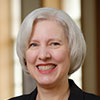This article is more than 5 years old.
The iPad with 3G is an amazing productivity tool at a conference! Quick intros from Barry and JP were extremely helpful in getting me started — thanks, guys! The 3G was absolutely key, because wifi in the convention center was spotty and the added mobility created opportunities. For example, I showed info to a new committee member on the Gale shuttle bus, which I wouldn’t have done with my ThinkPad.
Most of my conference was spent in governance meetings, either with the ALCTS Acquisitions Section committees or with the transition to being on the ALCTS Board. Topics the Board will grapple with during my term as section chair: meeting at Midwinter (or not), shifting more ALCTS publications to electronic instead of print, developing more continuing education webinars, “reshaping” the ALCTS organizational structure, and possibly changing the meeting schedule so that a person could possibly attend all meetings organized by a given section.
I squeezed in a few other events around my Vice-Chair duties and here are three highlights:
- JoVE (Journal of Visualized Experiments) is a brilliant concept. This peer-reviewed journal is the brain-child of a man with a PhD in stem cell biology, Moshe Pritsker, CEO, Editor-in-Chief and Co-founder of JoVE. As a grad student, Pritsker was unable to successfully replicate a published experiment by following complex written steps, so grant money had to be used to send him from the US to Edinburgh, UK to see the experiment performed. Because of this experience, Pritsker started a journal that not only publishes the steps but also has the video. According to Pritsker, JoVE had to be a journal, not videos on YouTube, to be successful: authors are motivated to publish in the framework that fits current tenure and recognition processes, and scientists turn to journals for their info. JoVe started as an open access journal but had to go to a subscription model to continue. It is the only video journal indexed in PubMed. Derrik, Carol and I are trying to figure out how we could get this innovative journal since several faculty have already expressed interest.
- Interest in patron-driven acquisitions of e-books using EBL and eBrary seems to be on the rise. Nancy Gibbs, of Duke University, reported out on a test and someone from Rice University in the audience said they are testing right now too, but on a smaller scale than Duke. I also just found a conference report on a blog for a session I couldn’t attend: http://www.libraries.wright.edu/noshelfrequired/?p=1118
- I spent some time at the Spacesaver booth working on storage planning jointly with Paul Rittelmeyer from University of Virgina (UVA) and the sales rep. UVA is replacing static shelving with the mobile shelving (Xtend) from Spacesaver; UVA’s project is running about 8 months behind ours, but there was utility in exchanging questions. For example, I learned that we need to communicate shelf “elevation” planning data to Spacesaver now — in other words we need to let the company know the heights of our books so they can hang the shelves to fit our collection size.

5 Comments on ‘Lauren C. At ALA Annual 2010: iPad, e-books, video experiments’
Very happy to hear you found value in the iPad!
I heard Moshe speak about JoVE at ScienceOnline 2009, when it was still OA, and was quite impressed. Glad to hear we might get it!
interesting Ipad info-sorry mine isn’t 3G.
thanks for the info Lauren.
Carpenter is planning to buy JoVE for WFU in August.
JoVE subscription is active and in your serials solution – but not under jove. Search “visualized”.